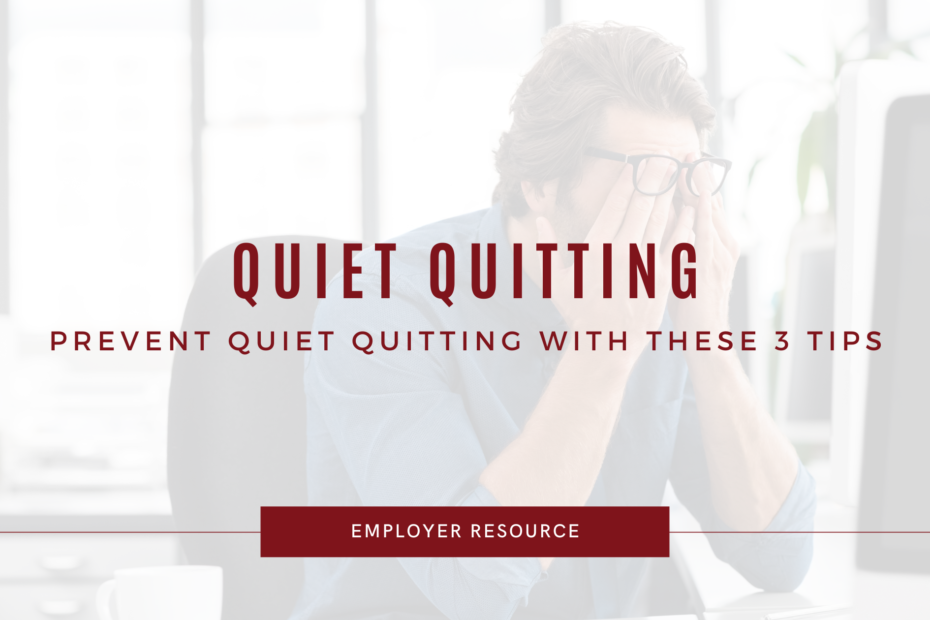Have you heard of the term “quiet quitting”? It’s one that’s been popping up around the Internet recently, specifically on LinkedIn.
If you aren’t familiar with this term, don’t worry – we’ll catch you up to speed and explain how to mitigate this phenomenon at your workplace.
What is quiet quitting?
Quiet quitting is when an employee becomes disengaged in their role and are performing at bare minimum levels, while quietly seeking alternative work. Quiet quitters may not outright quit their job, but they effectively quit the idea of working extra hours and taking on more than what is expected of them.
It’s not unusual for quiet quitters to be given a bad rap. They’re often labeled as “lazy” or “unmotivated,” when really these labels have nothing to do with who these people are as individuals. Instead, these traits are a result of their work environment.
Why are people quiet quitting?
Quiet quitting could result from a number of reasons. Among these might include burnout, feeling undervalued and unappreciated, or being taken advantage of.
But at its core, quiet quitting can stem from possible misalignment, a toxic workplace culture, or poor leadership. For example, a workplace culture that promotes working long hours and leadership that doesn’t set a good example of what a healthy work-life balance should look like can quickly cause employees to become disengaged.
Employees become disengaged when they don’t feel supported by their team and/or leadership. Disengagement will also happen when employees are constantly expected to take on more than their role requires without additional compensation or proper acknowledgement of hard work. This causes people to pull back from their work and begin putting in less effort – in other words, they quietly quit.
Prevent quiet quitting with these 3 tips
Here are 3 tips to boost your team’s engagement levels, promote a healthy work environment, and, ultimately, prevent quiet quitters:
- Build genuine connections and trust with your team. Make the time and effort to get to know your team on a personal level and build rapport. You might be thinking “well, duh!”, but many leaders overlook the importance of establishing and building authentic connections with their team. Additionally, following through with promises and fostering open and honest communication will create and maintain a higher level of trust between you and your team.
- Set and maintain realistic work expectations by leading through example. Set clear expectations right from the start regarding regular work hours, overtime, and the workload expected of each employee (i.e., their everyday tasks plus the types of projects they’ll be working on). As a leader, it’s also important to lead by example. Try to actively show your team what a healthy work-life balance looks like. This means that you shouldn’t be working late every day or sending out work-related communications past regular hours. (Pro tip: Both Microsoft Office and Slack have “schedule for later” functions, so that if you are working outside normal office hours, you aren’t disrupting others.) When your team sees you, the leader, taking work-life balance seriously, they won’t feel pressured to overwork themselves. Bye-bye, burnout!
- Recognize and reward high performance. Your team might not go above and beyond every day – and that’s alright. But when your employees do put in the extra effort to deliver a stellar project or ensure clients are happy, make sure their hard work doesn’t go unnoticed. Simple acknowledgment, a rewards system, growth opportunities, bonuses, or other perks are great ways to recognize their efforts!
Together, these 3 tips will help you prevent quiet quitting by encouraging a healthy work environment and strengthening your company’s overall culture. Your employees will feel more appreciated, less burnt out, and motivated to do their best at work (even if that doesn’t involve working more than 8 hours each day!).
Other useful resources:
- Read more about quiet quitting in this HBR article.
- Retain your top talent with our free Employee Retention Strategy Framework.
- Create an unstoppable team with our free Employee Development Tool.
- Follow the conversation on LinkedIn!
- Stay up to date on similar trends by subscribing to our monthly newsletter.
Need some extra support, not sure what to do next, or just need an ear? Book some time with our HR team today – we’re here to help!
